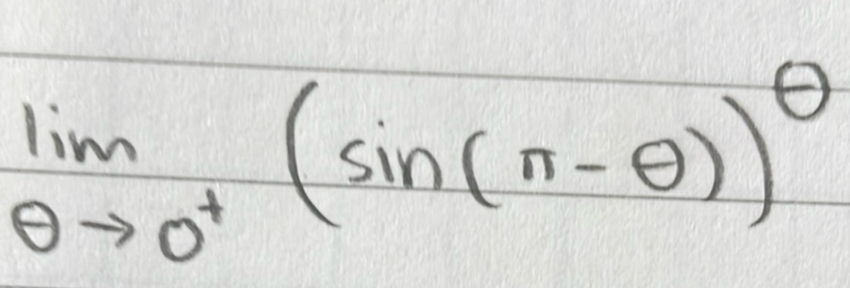AI tutor
Full solution
Q.
- Recognize symmetry of sine function: To solve the limit , we first need to recognize that is equivalent to due to the symmetry of the sine function.
- Rewrite expression with limit: Since is continuous and differentiable at , and , we can rewrite the expression as .
- Apply exponential and logarithmic functions: We can now apply the limit to the expression. However, the direct substitution of would result in the indeterminate form . To resolve this, we can use the exponential and logarithmic functions to transform the expression.
- Take natural logarithm of expression: Let's set and take the natural logarithm of both sides to get .
- Apply L'Hôpital's Rule: Now we can find the limit of as approaches from the positive side: .
- Evaluate limit of cotangent function: We can use L'Hôpital's Rule to evaluate this limit because it is in the indeterminate form . Differentiate the numerator and the denominator with respect to .
- Limit of natural logarithm is infinity: The derivative of the numerator with respect to is , and the derivative of the denominator with respect to is .
- Limit does not exist: Applying L'Hôpital's Rule, we get , which simplifies to .
- Limit does not exist: Applying L'Hôpital's Rule, we get , which simplifies to .As approaches from the positive side, approaches infinity. Therefore, the limit of as approaches from the positive side is infinity.
- Limit does not exist: Applying L'Hôpital's Rule, we get , which simplifies to .As approaches from the positive side, approaches infinity. Therefore, the limit of as approaches from the positive side is infinity.Since the limit of is infinity, the limit of is , which means the original limit is .
- Limit does not exist: Applying L'Hôpital's Rule, we get , which simplifies to .As approaches from the positive side, approaches infinity. Therefore, the limit of as approaches from the positive side is infinity.Since the limit of is infinity, the limit of is , which means the original limit is .However, is not a finite number; it represents that the function grows without bound. Therefore, the limit does not exist in the real number system.
More problems from Csc, sec, and cot of special angles
QuestionGet tutor help
QuestionGet tutor help
QuestionGet tutor help
QuestionGet tutor help
QuestionGet tutor help
QuestionGet tutor help
Question
. Find the value of in degrees.Write your answer in simplified, rationalized form. Do not round.____
Get tutor helpQuestionGet tutor help

